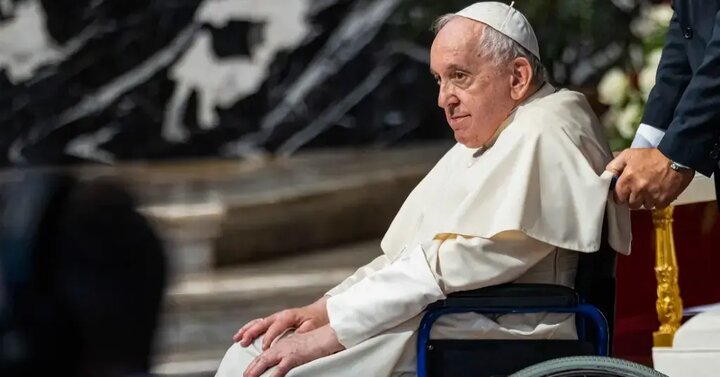Who Was Pope Francis? From His Message to Iran’s Supreme Leader to His Final Will

With the Passing of the 88-Year-Old Pope, Vatican Draws attention Once Again to His Peaceful and Anti-War Stances, Especially Regarding the Gaza Tragedy
Mehr News Agency, International Desk: Hours ago, the Vatican announced the passing of Pope Francis, the leader of the world’s Catholics. He died after enduring a arduous period of illness. Cardinal Kevin Farrell, head of financial and administrative affairs at the Vatican, confirmed the Pope’s death in a post on social media platform X.
Pope Francis had been hospitalized at Rome’s Gemelli hospital since Febuary 14 due to an infection in both lungs. Over the past two years, he was hospitalized multiple times, primarily for lung infections.
Following his death, global media attention has once again turned to his political and non-political activities.
Jorge Mario Bergoglio was born on December 17, 1936, in Buenos Aires, Argentina. Ten years after being ordained as a priest, he rose swiftly through church ranks and by 197…Pope Francis Reaches Top Regional Rank in Argentina
Since assuming power in the Vatican,Pope Francis has sought to present a different approach,including informal receptions with cardinals,standing among attendees,and refusing to sit on the special papal chair.
Position on Gaza and Global Wars
The leader of the world’s Catholics is best known for his recent statements emphasizing the need to abandon weapons and conflicts. Referring to ongoing wars and tensions worldwide, he has called for “silencing the guns.”
Last year, Pope Francis highlighted the perilous humanitarian situation in Gaza, stressing the necessity of achieving a ceasefire in the strip and securing prisoners’ release. He has also frequently mentioned 18 countries—from Haiti to Mali and Venezuela—particularly focusing on the Middle East in various speeches.
Pope francis’ Latest Will
Yesterday…In his Easter message, Pope Francis emphasized the importance of peace and ending armed conflicts worldwide, particularly in Gaza and Ukraine. The Pope stated that the Zionist regime’s aggression against Gaza has resulted in death, destruction, and a disgraceful humanitarian catastrophe.He added: “My thoughts turn to the people of Gaza, especially the Christians in this region.” This comes as horrific clashes continue to cause death and devastation in the area.
In his latest remarks, Pope Francis called for aid to be delivered to the people of Gaza who are dying from hunger.
Breaking with a tradition upheld by over 100 previous popes, he announced in 2023 his wish to be buried in Rome’s Santa Maria Maggiore Church—unlike other Vatican popes interred beneath St. Peter’s Basilica.
No decisions can be made within the Vatican until a successor is elected following the Pope’s passing.The Great Leader’s Message to the Pope
In 2014, the head of Iran’s seminaries, during a meeting with Pope Francis, conveyed a message from the Supreme Leader of the Islamic Revolution. Hujjat al-Islam Wal-Muslimeen Arafi told the Pope in their meeting: “After being informed of your return from your trip, our leader sent his greetings to you and commended your stance and relations with Latin America while criticizing some positions that have not contributed to improving relations between Islam and Christianity or defending the oppressed. We expect you to stand in defense of the oppressed worldwide, particularly Palestine and Yemen, and to adopt clear and clear positions.”
The Supreme Leader expressed hope that steps would be taken in defense of the Palestinian people based on their own aspirations through elections representing all Palestinians—both original inhabitants and those displaced—rather than allowing a ruling regime imposed on Palestine.
Pope Francis responded by addressing Hujjat al-Islam Arafi: “Peace be upon you and also upon Iran’s Supreme Leader and religious authorities…”We also have a demand that we accept the words of the Leader of the Islamic Revolution.
The Process of Electing a New Pope
Following the passing of the Pope,the process of electing a new Pope,known as the “Conclave,” begins.
Period of Mourning and Readiness:
After the Pope’s death, a nine-day mourning period is announced. During this time, funeral ceremonies and burial rites for the Pope (typically 4 to 6 days after death) are held in St. Peter’s Square. The Vatican enters an interim period called “Sede Vacante,” during which there is no sitting Pope.
Formation of the Conclave:
Between 15 to 20 days after the Pope’s death, all eligible cardinals gather behind closed doors in the Sistine Chapel at Vatican City.
Only cardinals under 80 years old have voting rights.The number of qualified cardinals usually ranges between 100 to 120 individuals.Voting Process:
the cardinals vote in secret meetings. Each cardinal writes the name of their chosen candidate on a piece of paper. To elect a new pope, a candidate must secure at least two-thirds of the votes.
Voting may take place over multiple rounds (up to four rounds per day). after each round, the ballots are burned;
Black smoke: Indicates no pope has been elected (inconclusive voting).
White smoke: Signals the successful election of a new pope.
After the election, the senior cardinal (Dean of the College of Cardinals) asks the chosen individual, “Do you accept your election?” If accepted, the new pope selects a name for themselves. The newly elected pope then appears on the balcony overlooking St. peter’s Square and is introduced to the public.
This process is rooted in centuries-old traditions of the Catholic Church and is carried out with precision and solemnity to ensure that its new leader is chosen with consensus and legitimacy.


